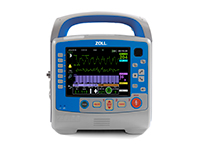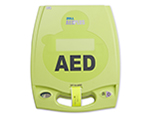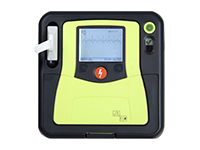Pediatric Defibrillation
ZOLL® has developed a dedicated pediatric arrhythmia analysis algorithm that can distinguish between shockable and non-shockable pediatric rhythms. This unique algorithm is available on ZOLL defibrillators, including the ZOLL AED Plus®, AED Pro®, and certain configurations of the ZOLL AED 3® defibrillators, as well as on the R Series® and the X Series® Advanced monitor/defibrillators.
When a device that uses this algorithm senses that pediatric electrodes, or pads, are attached, it switches from adult to pediatric mode and performs a complex rhythm analysis. Pedi-padz® II pediatric electrodes are designed especially for use with the ZOLL AED 3 BLS, AED Plus, and AED Pro defibrillators, as well as the X Series Advanced monitor. CPR Uni-padz® electrodes are designed to work with the ZOLL AED 3 defibrillator. The OneStep™ Pediatric electrodes work with the R Series and X Series to automatically lower the energy setting to 50 joules, preventing accidental overdose during defibrillation while still allowing for the delivery of sufficient current.
How to Defibrillate a Child
When a child experiences sudden cardiac arrest or a similar kind of arrhythmia, it’s necessary to act fast to give them their best chance at survival. For many children, defibrillation is needed when they are already in the hospital. Under these circumstances, a trained care team would use a manual defibrillator as well as high-quality CPR to give them the best treatment possible.
However, if a child outside of the hospital becomes unresponsive, stops breathing, or ceases to have a pulse, bystander intervention is crucial to survival. As soon as you notice a child experiencing symptoms of sudden cardiac arrest, call 911, begin delivering high-quality CPR, and ask another bystander to locate a nearby AED.
One rescuer should continue delivering CPR while another rescuer readies the AED. Connecting a child to an AED differs from connecting an adult to one. Always follow the guidance provided by the AED you're using in a rescue situation.
How to Use a Pediatric Defibrillator: Nine Steps
When using a ZOLL defibrillator on pediatric patients, the following steps will help you assist them.
Note: These instructions are for informational purposes; always follow local protocol when operating an AED.
-
Retrieve the AED
- Open the case.
- Turn on the AED.
-
Expose the child's chest.
- Make sure the chest is dry.
- Remove any obstructions, such as medical patches, a pacemaker, jewelry, etc.
-
Open the pediatric electrodes packaging
- Peel off the adhesive backing.
-
Apply the pads. Exact application instructions should be on the packaging.
- Generally, rescuers should first roll the child over and center the back electrode along the spine between the shoulder blades. Reorient the child on their back and place an electrode on their front, near their sternum.
- When applying pads, secure one edge of the pad to the patient. “Roll” the pad smoothly from that edge to the other, taking care not to create any air pockets when applying the pads.
-
Ensure all cables are attached to the AED.
-
Move away from the child.
- Stop CPR.
- Ask others not to touch the child.
-
Let the AED analyze the child’s cardiac rhythm to determine whether a shock is necessary. Some models automatically deliver a shock, while others require the rescuer to push a button.
-
Resume CPR once the AED indicates a shock has been delivered.
-
Continue to alternate between defibrillation and CPR until the child responds or until paramedics arrive.
Algorithms for Pediatric Advanced Life Support
Caring for pediatric patients requires a complete understanding of the most current pediatric advanced life support algorithms (PALS) to ensure the best possible patient outcome.
- Pediatric cardiac arrest
- Pediatric bradycardia with a pulse
- Pediatric tachycardia with a pulse
- Neonatal resuscitation
- Post cardiac arrest checklist
Common Questions about Pediatric Defibrillation
Rescuers can ensure they're delivering the best possible care by reviewing frequently asked questions about defibrillating pediatric patients.
Can you use an AED with adult-sized pads on a child?
AEDs with adult-sized pads can be used to treat patients over the age of 8. For patients 8 and under, the AHA recommends using pediatric pads. Keep in mind that pediatric pads are applied differently than adult pads — they need to be adhered to the patient's chest and back.
What is the recommended shock level for a pediatric defibrillator?
When using a manual pediatric defibrillator, begin with a dose of 2 J/kg and use 4 J/kg for any subsequent attempts. If you are using an AED that supports pediatric pads, it will automatically decrement the shock level to the starting dose.
Where should you place AED pads on a child?
If a child is under the age of 8, pediatric AED pads should be attached to the front and back of the child, with one located near the sternum, and another located between the shoulder blades.
What is the maximum weight limit when using ZOLL pediatric AED pads?
ZOLL pediatric pads are safe for children 55 pounds (25 kg) and under who require a lower current to defibrillate the heart. Always refer to the instructions on any pediatric pads to ensure they are appropriate and safe for the weight of the child.
What are some things to consider before defibrillating a child?
Due to their smaller size and unique physiology, be sure to consider the following before using a defibrillator on a child: energy levels, electrode placement, medical oversight, and CPR.
How many joules are delivered in a pediatric defibrillation?
The amount of joules delivered in a pediatric defibrillator can vary depending on the device and the child's size and age. For example, the ZOLL AED Plus defibrillator has a pediatric mode that delivers a fixed energy level of 50 joules for infants and children under 8 years of age, and then increases to 70 joules for larger children.
What age range is appropriate for the use of pediatric defibrillation pads?
Pediatric defibrillation pads are designed for use on infants and children up to 8 years of age or weighing less than 55 pounds (25 kg).








